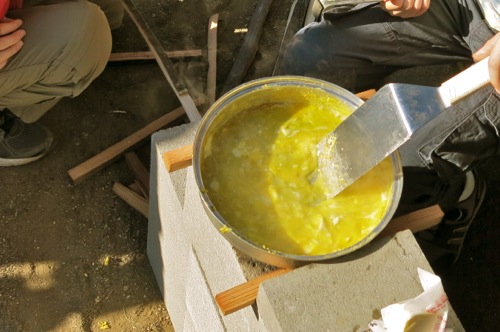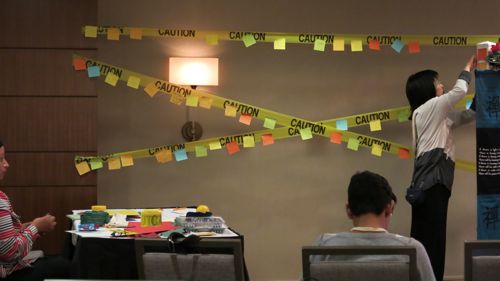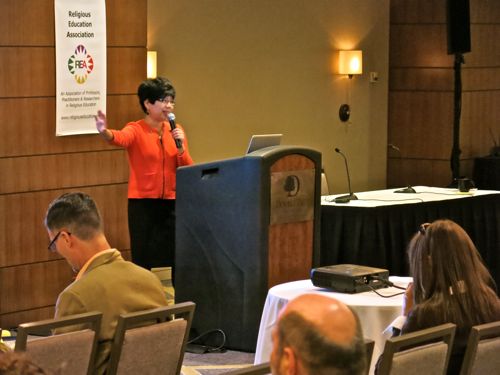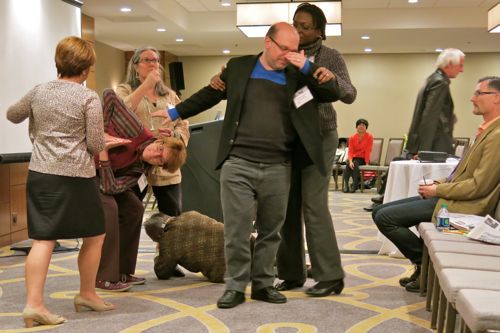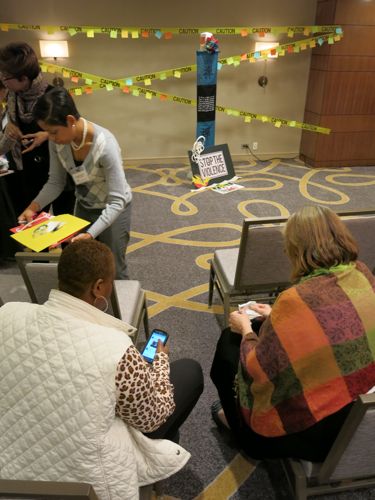This is my retelling of one section of “Visits to Strange Nations,” which may be found (in translation) in the section on “Anonymous Chinese work of the 17th century,” Gems of Chinese Literature, 2nd ed., trans. Herbert A Giles (Shanghai: Kelly and Walsh, 1923). This story was also retold by Sophia Fahs in From Long Ago and Many Lands, available online through Google Books — click here. My version of the story has a different bias than does Fahs’s version, and perhaps hews closer to the original.
THE LAND OF THE GREAT
In the year 684, the scholar T’ang Ao and his friend Lin Chih-yang grew disgusted with the behavior of Empress Wu, ruler of their home land of China. These two friends thought the empress was both foolish and aggressive, and they also felt that under her reign anything might be bought or sold, including a person’s honor. They decided they would travel the world and see how other nations were ruled, and so they found a guide, a man named Toh Chiu-kung who seemed to know everything and to have traveled everywhere, and then they got on board a ship and sailed over the sea.
After visiting several nations, they came at last to the Land of Great People. In fact, they almost passed by this small nation except that T’ang had heard that in the Land of the Great, no one walked but instead everyone had their own personal cloud which carried them where they wanted to go. Toh warned that they would have to leave the ship and walk a long way inland to really see this country. But T’ang must go see the Land of the Great, so they began to walk inland over some steep hills.
Soon they became lost in a maze of trails, and did not know which way to turn. They were very glad when at last they saw a small temple hidden in among bamboos. Out of the temple came an old man who looked perfectly ordinary except for two things. First, he was riding on a cloud. Second, while in their country anyone who lived in a temple would have to be a priest who shaved their head, did not eat meat, did not drink wine, and was not married — well, this old man had long hair, carried a glass of wine in one hand, a plate of meat in the other hand, and through the door they could see his wife seated at a table.
It is hard to say which shocked the two friends more — a man floating upon a cloud, or a long-haired, meat-eating, wine-drinking, married priest! However, they remained polite. The old man smiled at them, put down his wine and meat, and invited them into the temple. T’ang, speaking for his friends, bowed low and asked what the name of the temple. The old man replied that it was the temple of the goddess of mercy, and that he was the priest of the goddess.
Upon hearing this, Lin asked, “But, respected sir, how can it be that you are a priest but do not shave your head?” Lin decided not to ask about the wine or the meat, or the man’s wife.
“My wife and I have lived here and been the priests ever since we were young,” said the old man. “Every day, we burn incense and candles before the shrine. Here in our country, when we heard that China had accepted the Law of the Buddha, and that priests with shaved heads had become common there, we too decided to accept the Law of the Buddha, but we decided to do away with the usual promises of a priest. Thus we can grow our hair, get married, eat meat, and drink wine.”
When the old man learned that his visitors were from China, he urged them to stay with him. But no, they said they must go on to see the chief city of the Land of the Great.
“But could you please answer one question,” said T’ang. “Could you please explain the reason why the people of your country all have clouds underneath their feet? Is this something that you are born with?”
“Yes, we are born with these clouds,” said the old man. “The clouds come in various colors, and colors change depending on the character of each person. The best clouds have stripes like a rainbow. The second-best clouds are yellow in color. The worst clouds have no color at all, and look dark, as if there is nothingness, or a hole, underneath the person’s feet.”
T’ang asked the old man to show them the way to the city so they could see more of these clouds, and the old man explained which trail to follow.
Soon they were in the great city. There were throngs of people in the city streets, each moving around on a small cloud. They saw clouds of many different colors: red, yellow, orange, green, and so on. At last they saw a homeless man, who obviously hadn’t taken a bath in weeks, whose cloud looked like a brilliant rainbow.
“Why, the priest told us that a rainbow cloud was best of all,” said T’ang, “and here we see a filthy, dirty homeless person with a rainbow cloud!”
“You may remember,” said Lin, “that that priest had a rainbow cloud himself. Yet how could a wine-drinking, meat-eating, long-haired, married priest be considered to be a good person? Just so, how could a homeless person be considered to be a good person? There is something here I do not understand.”
“As you know,” said Toh, their guide, “I have been to this country before. What I learned then was that the color of a person’s cloud comes from the kind of person they are, from the kinds of actions they take, but it does not matter whether they are rich or poor. So the clouds of good and virtuous people show the best colors, and the clouds of wicked people show the worst colors, whether they like it or not. The only way you can change the color of your cloud to a better color is to become a better person, and it does not matter if you are homeless, or if you a priest who eats meat.
“Because of this fact,” continued Toh, “there are poor people who ride on rainbow clouds, as we have just seen, and there are rich and powerful people whose ride on clouds that lack all color at all, and look like holes of darkness. Of course, everyone avoids the people who have a cloud of darkness. On the other hand, the people of this country get the greatest pleasure from seeing acts of kindness. So it is that people are not constantly trying to get the better of each other; no, they are always trying to become better people.”
“Is this why they are called the Land of the Great?” asked T’ang.
“Yes,” said Toh. “The people in the nations next to this one call them the Land of the Great — not because they are bigger and taller than other people, but rather because they are high-minded and good.”
Suddenly they noticed that the people around them were pushing back to the sides of the street, leaving the center of the street to a person of great wealth and power, who looked almost exactly like a wealthy powerful person in their own land, with a red umbrella over his head, with assistants in front and behind carrying official documents and beating gongs, and so on. The difference was that this wealthy person was riding on a cloud that was carefully and completely covered by a red silk cloth.
“Obviously,” said T’ang, “in this country, the wealthy and powerful do not need to ride on horses, for they can move about on these convenient clouds. But one thing I do not understand — why is this man’s cloud mysteriously covered by a red silk cloth?”
“The fact is,” said Toh, lowering his voice so he could not be heard except by the two friends, “this man, like too many other people with lots of money and a high social position, has a cloud of a bad color. His cloud is not exactly one of those horrible clouds of dark nothingness. But his cloud is the color of charcoal and ashes. This means he is not completely bad, but it does mean — as we like to say — that his hands are not so clean as they ought to be.”
“In other words,” said Lin, “he is not exactly a wicked person, but he most certainly is not a good person.”
“That is a good way of putting it,” said Toh. “His cloud takes on the color of his inmost mind. He is not a good man, and so his cloud a bad color. He tries to cover up his bad-colored cloud with red silk, but red silk does not change the color of his cloud. Nothing will change the color of his cloud until his heart becomes good again, until all his actions are once again good. But still, he covers his cloud with red silk, because at least that way no one is quite sure just how bad he really is.”
“How unjust this is!” cried Lin.
“But why do you think this is unjust?” asked T’ang.
“It is unjust that these clouds exist only here, in the Land of the Great,” said Lin. “It would be very useful if we had these clouds in our own nation, for if every wicked person rode about upon a marker of their wickedness, why, that would make good people’s lives easier.”
“My dear friend,” said Toh, “though wicked people in our nation do not ride about on colored clouds, nevertheless you can tell from a person’s looks what the color of their heart is. Someone with a bright, shining look in their eyes surely must have a rainbow-colored heart. And we all know people who have a blankness in their looks that shows an emptiness in their hearts.”
“That may be so,” answered Lin, “but I for one have been fooled by a person’s looks. I would rather we could see the color of the cloud they ride about on.”
Notes:
The story comes from the Chinese novel Ching Jua Yuan, which was written in the 17th century by Li Ju-chen, and is “an allegoric romance in total support of Confucian morality and Taoist wisdom” (C. T. Hsia, “The Scholar-Novelist and Chinese Culture: A Re-appraisal of Ching Hua Yuan,” in Chinese Novel: Critical and Theoretical Essays, ed. Andrew H. Plaks [Princeton University, 2014], p. 266). As such, it is a useful source for portraying to children Confucian ideals of morality. Young T’ang Ao and his friend Lin grow disgusted with the state of morals in their own country; and so they go on visits to other nations, where they find strange peoples who are in some sense more moral than in their own country.
Some scholars have seen this novel as a satire of the position of women in traditional Chinese society (for one such interpretation see Lin Yutang’s Feminist Thought in Ancient China, 1935). I have included a second episode from the novel (see no. 3 below) that gives some taste of that possibility. If, in the episode above, there is little evidence of any feminist inclination, it is important to know that that inclination does exist elsewhere in the novel. Thus, while the novel may support traditional Confucian morality, there existed more than one interpretation of that traditional morality; and this particular interpretation of Confucianism was more progressive in its attitudes towards women than others.
In addition to the Confucian component, there is also a strong Taoist component to the novel. Toh Chiu-kung, for example, becomes a wise elder to the two young men: “He is in one sense almost co-eval with the Yellow Emperor and certainly enjoys the free and easy wandering of Chuang Tzu and Lieh Tzu” (C. T. Hsia, p. 278). Toh, the guide, is a sort of Taoist sage-figure, guiding the two younger men on their visits to strange nations.




